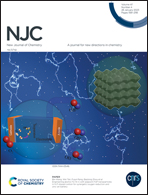Phosphorus–nitrogen compounds: part 68. Synthesis, characterization, stereogenism, photophysical and bioactivity studies of novel unsymmetrical dispiro(N/N)cyclotriphosphazenes with carbazolyl and 4-chlorobenzyl pendant arms†
Abstract
Organic–inorganic hybrid multi-heterocyclic unsymmetrical cis/trans dispirocyclotriphosphazenes with different pendant arms were obtained and their spectral, stereogenic, photophysical and bioactivity properties were investigated. To prepare these phosphazenes, the starting compounds tetrachloro(4-chlorobenzyl)spiro(N/N)cyclotriphosphazenes, (ClBzSpiro-5)R1(N3P3)Cl4 [Bz: Benzyl; R1: Me (1) and R1: Et (2)], were prepared regioselectively from the reactions of hexachlorocyclotriphosphazene, N3P3Cl6 (HCCP, trimer) with N-methyl/ethyl-N′-(4-chlorobenzyl)-1,2-diaminoethanes. Reactions of tetrachlorocyclotriphosphazenes (1 and 2) and 9-ethyl-N-methyl-3-carbazolyl-1,2-diaminoethane (3) or 9-ethyl-N-methyl-3-carbazolyl-1,3-diaminopropane (4) produce new cis/trans-dispirocyclotriphosphazenes, [(ClBzSpiro-5)R1(N3P3)(CzSpiro-n)R2]Cl2 (Cz: Carbazolyl; R1, R2: Me or Et; n = 5 or 6; (5a–8a and 5b–8b), containing unsymmetrical spiro-architectures. In addition, the structures of trans-7a and cis-7b isomers were clarified by single crystal X-ray crystallography. The chiralities of trans-7a and cis-7b were confirmed using X-ray crystal structures, 31P NMR spectra recorded upon the addition of chiral solvating agent [(S)-(+)-2,2,2-trifluoro-1-(9′-anthryl)ethanol; CSA], and circular dichroism (CD) spectra. Moreover, the photophysical properties of phosphazenes showed a fluorescence profile with lifetimes of about 4.9–6.6 ns and quantum yields in the range of 0.10–0.14. Additionally, the antibacterial and antifungal activities of the newly synthesized phosphazenes against some bacteria and yeast strains and their interactions with pBR322 plasmid DNA were investigated. The bacterial strain most susceptible (MIC = 156.3 μM) to compounds 5a and 8a was P. aeruginosa. However, it was found that the yeast strain most susceptible (MIC = 156.3 μM) to compounds 5b, 7a, 7b and 8b was C.albicans. The cytotoxic activities of 5a, 5b, 7b and 8a against L929 fibroblast and MCF-7 breast cancer cells were determined. However, cis-5b showed reasonable antioxidant activity with a radical scavenging value of 35.20%.



 Please wait while we load your content...
Please wait while we load your content...